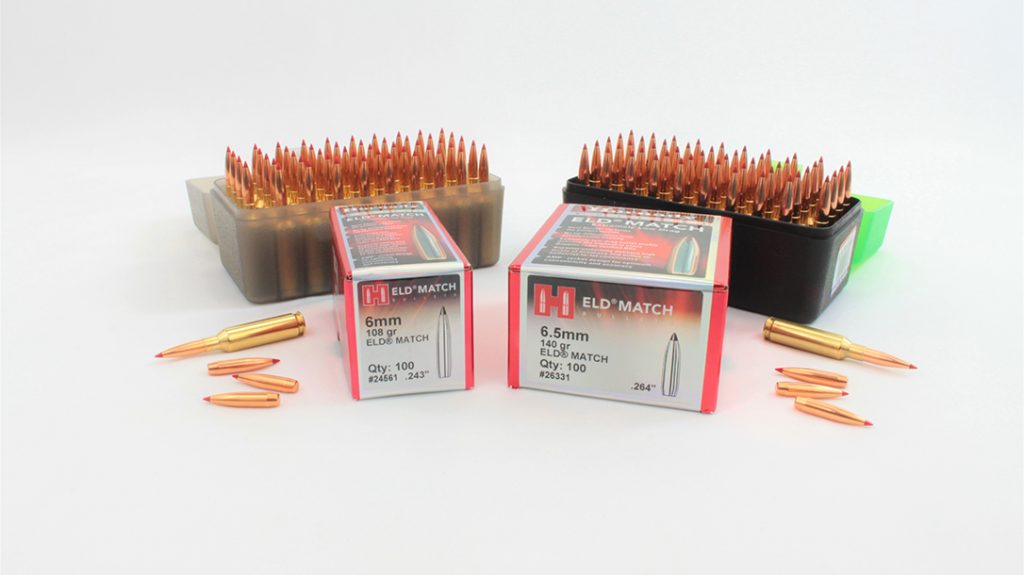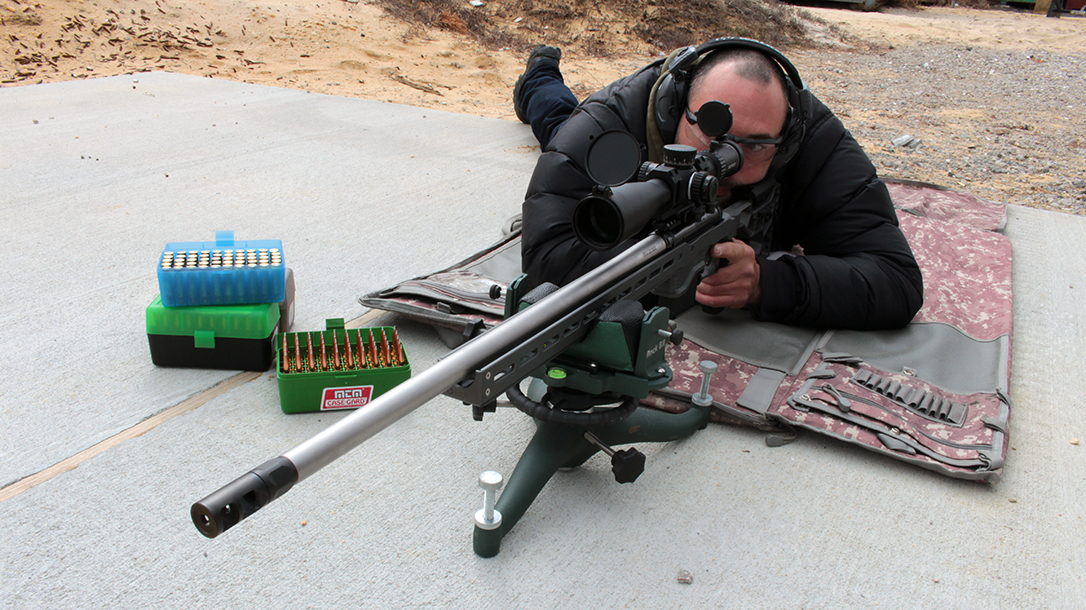If you ask any serious handloader, he or she will likely exclaim that accuracy is both an addiction and an enigma. It’s an enigma because conventional wisdom leads you to believe that there is no way a mass-produced piece of metal can get blasted through a tube the same way every time. It becomes an addiction after you prove it to yourself and just want more. The Hornady Aluminum Tip (A-Tip) helps feed that addiction.
Hornady Aluminum Tip Details
Naturally, this realization walks a precision shooter out of the ammunition aisle and down the deep, dark aisle of reloading supplies. Ah, I can smell it now—sort of like stale whiskey and cigar smoke rife with euphemisms like “dime-sized groups” and “one ragged hole” permeating the air. We are an accuracy-obsessed bunch indeed. This obsession leads us into discussions as to which component, and even which portion of a component, is the most important for accuracy. There are lots of theories on this, but if you asked Hornady, I would wager a fistful of powder that they would say it is the meplat, or tip of the bullet.
Just the Tip
Hornady has always put emphasis on this critical part of the projectile, which is evident as far back as the introduction of the company’s A-MAX bullet all the way up to the new 6mm ARC. The argument was that polymer is far easier to manipulate than copper, and thus easier to make “the perfect meplat.”
Advertisement — Continue Reading Below
Everything was great in the world of long-range shooting and hunting until the ammunition giant invested in Doppler radar. As the ballisticians at Hornady fiddled with their new toy, they found something that they just didn’t like: aerodynamic melting. This phenomenon revolves around the heat generated when a projectile with a very high ballistic coefficient (BC) slips through the air. In this instance, the tips melt just enough to make a ballistician uneasy, but for years the end-user never noticed.
The businessman in me says, “Eh, leave it.” I mean, if the shooters themselves aren’t complaining about accuracy loss, why change it? However, this is not, and never has been, the way Hornady approached such issues. Armed with this knowledge, engineers modified their polymer material. They also reshaped some of their most popular bullets to create the ELD Match line. Just like the A-MAX bullets, the ELD Match line gained immediate attention and began winning competitions across the globe.
Setting the Standard
The problem with building such a good bullet is that it became the standard for long-range shooting, so everyone began using it. Hornady needed a new product that appealed to those truly obsessed with accuracy and have the skill and equipment to reap the rewards. With this ever-evolving class of shooter in mind, Hornady brings us the A-Tip. The ELD Match bullets really delivered in the accuracy department. So the A-Tip bullet delivers more than just an accuracy improvement. Hornady designed it for consistency as well.
Advertisement — Continue Reading Below
Every A-Tip features a finely turned aluminum tip. This material change not only seals the deal on aerodynamic heating but changes the entire geometry of the bullet. Also, each tip fits each specific projectile. Hornady did not make designers attempt fitting a handful of available tips. This allows for “sky’s the limit” creativity, and the results certainly prove it. Lastly, the bullets come packaged sequentially off of the assembly line. The process exhibits the least amount of tooling inconsistency possible among any given 100-projectile box.
Test Components
I requested two of Hornady’s most popular A-Tips: the 110-grain 6mms and 135-grain 6.5mms. Then, for a control group, I decided to run the A-Tip projectiles against their closest polymer-tipped 6mm and 6.5mm counterparts at 108 and 140 grains, respectively. For my cases, I chose Starline’s newest foray into bottlenecks with small primer pockets.

Advertisement — Continue Reading Below
To avoid overpressure issues, I used a propellant built specifically for the Creedmoors: Winchester’s StaBALL powder. This new propellant boasts ball-powder metering with the temperature stability of the more popular extruded-rod freedom flakes. Finally, although many choose magnum primers to ignite ball powders, I went with CCI BR-4 primers, as they are made for benchrest applications, and this was going to be a borderline endeavor.
With all components in hand, I set up my reloading bench and got to work. To weigh my powder, I used an RCBS MatchMaster dispenser. This next-generation measurer is accurate to within 0.04 grains—more than twice that of the industry standard of 0.1 grains. This rules out the possibility of powder variances from case to case.
All in the Family
While there are a lot of dies on the market, I found that using Hornady dies to seat Hornady bullets is very helpful, as you can also use the custom-made seater stem for each individual projectile. This ensures that you don’t lay waste to all of that precision manufacturing by damaging the bullet as it’s seated. As recommended, I ran the cases through the sizing die and lightly chamfered and deburred each one, ensuring smooth, gentle seating later on. Lastly, I determined my optimal overall length by using the Hornady OAL tool and subtracted 0.01 inches to ensure my final round would chamber.
Advertisement — Continue Reading Below
Loading the bullets went just as expected without anything really notable during the process. However, there were a few interesting aspects of loading the A-Tips. First, I noticed that the A-Tips leave the factory without any cleaning or polishing. This is done to ensure that they do not get separated from their batch mates. A cotton bag comes with each pack so you can shine them to your tastes if you wish.
Setting Up
Second, I noticed that when seated to touch the lands, the bullets were a hair out of magazine length and either needed to be seated a little deeper or fed by hand if I wanted to stuff more than two in. I chose the former, as I wanted both rounds to have the advantage of a close-to-rifling start. As promised, the powder amazingly threw to within the 0.02-grain mark and filled the entire case in most instances without burying the bullet into the powder column. This goes to show that a tremendous amount of research and development went into Winchester’s powder as well.
As for the guns, I decided to use a pair of Savage 110 Elite Precision rifles in each chambering. I chose the Savage Elites because, again, I know that if I don’t have a rifle that can shoot 1-MOA group, I’m probably not going to notice any accuracy increase that the A-Tips provide. I topped the 6mm Creedmoor rifle with a 4.5-27x50mm Bushnell Forge scope in a one-piece Warne XSKEL mount. Between the 20-MOA base and the 20-MOA rail, I was worried that I wouldn’t be able to achieve a 200-yard zero, but luckily that wasn’t the case. For the 6.5 Creedmoor, I had a 5-25x50mm Riton X5 Conquer scope already set up in a quick-detach American Defense Manufacturing mount, so I snapped it on and was ready to rock.
Advertisement — Continue Reading Below
Range Day
With 40 different handloads ready to go, I scheduled the calmest morning I could, which isn’t really saying a lot for March on Eastern Long Island. When I found a day down to just a 5- to 10-mph tailwind, I seized the opportunity and headed to my favorite 200-yard test facility. While the firearms industry standard is 100 yards for load testing, I decided to stretch it out to 200 yards to better view the variances between the ELD Match bullets and A-Tips. But before I go any further, it’s important to understand that the A-Tip isn’t simply an ELD Match bullet crafted from aluminum. Consequently, this experiment isn’t a comparison of polymer versus aluminum, but a comparison of one high-end product versus Hornady’s platinum-level pills.
I unpacked and got cozy in the prone position with a rear bag and a Caldwell Rock BR rest. I liked the Caldwell rest for this test. The Savage rifles’ chassis fit perfectly, eliminating all undesired movement. I noticed the unique smell fo the StaBALL powder, first of its kind, during testing. I also had some “hang fires” on the lighter charges—maybe I should have used those magnum primers after all.
Dialed In
In that same vein, the cases didn’t completely seal the chamber until I passed the halfway mark of the powder charge range, leaving me with some dirty brass. However, once I got to the heavier charges and got these bullets moving—wow! Both rifles created 0.5-MOA groups, with many four-shot groups falling inside 0.25 MOA. Mind you, that is also at 200 yards with a bit of a tailwind. I also didn’t experience any pressure issues, which is simply amazing, especially with the maximum charge.
Advertisement — Continue Reading Below
The verdict? The A-Tips certainly did better than the ELD Match bullets. However, as I mentioned, it takes the right kind of shooter and equipment to appreciate how much. Overall, I saw more consistency with the new aluminum-tipped projectiles and had far fewer flyers than the polymer ELDs. This means that on long-range steel targets, your hit rate will improve dramatically.
The 6mm A-Tips outperformed their closest polymer counterpart by more than 0.5 MOA; it gave us 200-yard groups inside of 1 inch. Over in 6.5 land, the ELDs actually slightly “outperformed” the A-Tips; their best overall 200-yard group measured 1.43 inches to the A-Tips’ 1.45 inches. But the first three started great. Overall, I saw less shot-to-shot variances on these as well.
Hits & Misses
While it might not seem like much, 0.25 MOA could be the difference between a hole in the 10-ring or one in the tie-breaking X-ring. For those engaging steel in PRS-style shooting, remember that this is 2.5 inches at a 1,000-yard target, which can be the difference between a hit and a miss.
Advertisement — Continue Reading Below
When you add it up, these A-Tip bullets are intended for those looking to squeeze that last bit of precision out of their rifles and possibly edge out the competition, or maybe those who just want to see how good their shootin’ iron can actually perform. Whether you’re considering switching to these projectiles or not, make sure you try a box. It’ll certainly be an eye-opening experience. For more information, visit hornady.com.
This article is from the June/July 2020 issue of Tactical Life magazine. Grab your copy at OutdoorGroupStore.com.
























